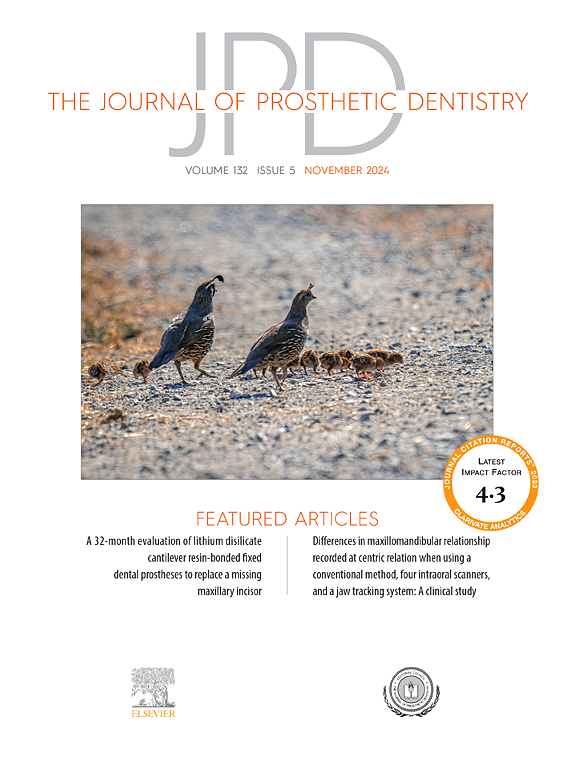不同照射时间和距离对聚醚压印材料体外消毒效果和物理性能的影响
IF 4.8
2区 医学
Q1 DENTISTRY, ORAL SURGERY & MEDICINE
引用次数: 0
摘要
问题说明:当暴露于化学消毒剂时,聚醚压印材料可能容易吸水,而紫外线- c (UV-C)辐射可作为替代消毒方法。然而,对聚醚材料在UV-C照射后的消毒效果和物理性能研究较少。目的:研究聚醚压印材料在不同时间和距离紫外线照射后的消毒效果、接触角和线性尺寸变化。材料和方法:制作盘状聚醚标本,按2个距离(8cm和16cm)和6种消毒方法分为12组:无紫外线(UV0)、紫外线照射2.5、5、10或30分钟(UV2.5、UV5、UV10和UV30)和0.5%次氯酸钠(NaOCl)浸泡10分钟。对变形链球菌和白色念珠菌的消毒效果、接触角和线性维度变化进行评价。数据分析采用双因素方差分析,以暴露时间和暴露距离为主要因素,然后进行Tukey诚实显著差异检验(α= 0.05)。结果:对于这两种微生物,UV2.5、UV5和UV10组在8 cm处的残留微生物细胞数量比在16 cm处的显著减少(p < 0.05)。在8厘米处和16厘米处分别照射10分钟和30分钟后,微生物被完全清除。对比暴露时间,除了UV30组在8 cm处以及UV5、UV10和UV30组在16 cm处暴露时间增加外,变形链球菌和白色念珠菌的残留数量随暴露时间的增加而显著减少(p < 0.05)。各组别的尺寸变化率在0.11% ~ 0.31%之间,均低于国际标准化组织1.5%的规范限值。结论:在8厘米处进行10分钟的UV-C辐射有效消毒聚醚压印材料,其效果与在0.5% NaOCl中浸泡10分钟相当。在8或16厘米处进行30分钟的UV-C辐射,可有效消毒聚醚压印材料,增强表面润湿性,并保持尺寸稳定性。本文章由计算机程序翻译,如有差异,请以英文原文为准。
In vitro evaluation of disinfection efficacy and physical properties of polyether impression material after ultraviolet-C radiation with different exposure times and distances
Statement of problem
Polyether impression material may be susceptible to water absorption when exposed to chemical disinfectants, and ultraviolet-C (UV-C) radiation could serve as an alternative disinfection method. However, studies on the disinfection efficacy and physical properties of polyether material after UV-C radiation are lacking.
Purpose
The purpose of this in vitro study was to evaluate the disinfection efficacy, contact angle, and linear dimensional change of polyether impression material after exposure to UV-C radiation at varying times and distances.
Material and methods
Disk-shaped polyether specimens were fabricated and divided into 12 groups based on 2 distances (8 cm and 16 cm) and 6 disinfection methods: no UV (UV0), UV radiation for 2.5, 5, 10, or 30 minutes (UV2.5, UV5, UV10, and UV30), and a 10-minute immersion in 0.5% sodium hypochlorite (NaOCl). Disinfection efficacy against Streptococcus mutans and Candida albicans, contact angle, and linear dimensional change were evaluated. Data were analyzed using the 2-way ANOVA with exposure times and distances as main factors, followed by the Tukey honestly significant difference test (α=.05).
Results
For both microbes, the UV2.5, UV5, and UV10 groups at 8 cm exhibited a significant reduction in the number of residual microbial cells compared with those at 16 cm (P<.001). Conversely, the UV0, UV30, and NaOCl groups showed no significant differences (P>.05). Complete microbial eradication was achieved after 10 minutes of UV-C radiation at 8 cm and 30 minutes at 16 cm. Comparing exposure times, the number of residual Streptococcus mutans and Candida albicans cells significantly decreased as UV-C exposure time increased for both distances (P<.001). All groups exhibited no significant differences in contact angle compared with the UV0 group at either distance (P>.05), except for the UV30 group at 8 cm and the UV5, UV10, and UV30 groups at 16 cm. The percentage of dimensional change in all groups ranged from 0.11% to 0.31%, all of which were below the International Organization for Standardization specification limit of 1.5%.
Conclusions
A 10-minute UV-C radiation at 8 cm effectively disinfected polyether impression material, comparable with a 10-minute immersion in 0.5% NaOCl. A 30-minute UV-C radiation at either 8 or 16 cm effectively disinfected polyether impression material, enhanced surface wettability, and maintained dimensional stability.
求助全文
通过发布文献求助,成功后即可免费获取论文全文。
去求助
来源期刊

Journal of Prosthetic Dentistry
医学-牙科与口腔外科
CiteScore
7.00
自引率
13.00%
发文量
599
审稿时长
69 days
期刊介绍:
The Journal of Prosthetic Dentistry is the leading professional journal devoted exclusively to prosthetic and restorative dentistry. The Journal is the official publication for 24 leading U.S. international prosthodontic organizations. The monthly publication features timely, original peer-reviewed articles on the newest techniques, dental materials, and research findings. The Journal serves prosthodontists and dentists in advanced practice, and features color photos that illustrate many step-by-step procedures. The Journal of Prosthetic Dentistry is included in Index Medicus and CINAHL.
 求助内容:
求助内容: 应助结果提醒方式:
应助结果提醒方式:


